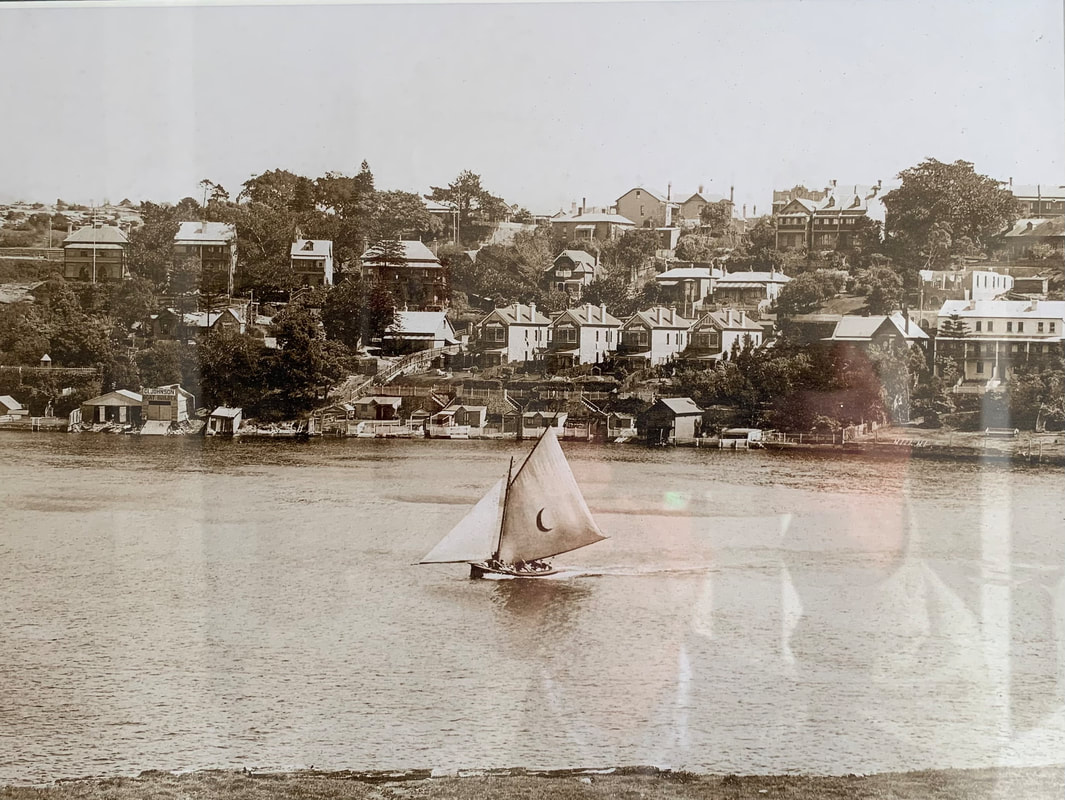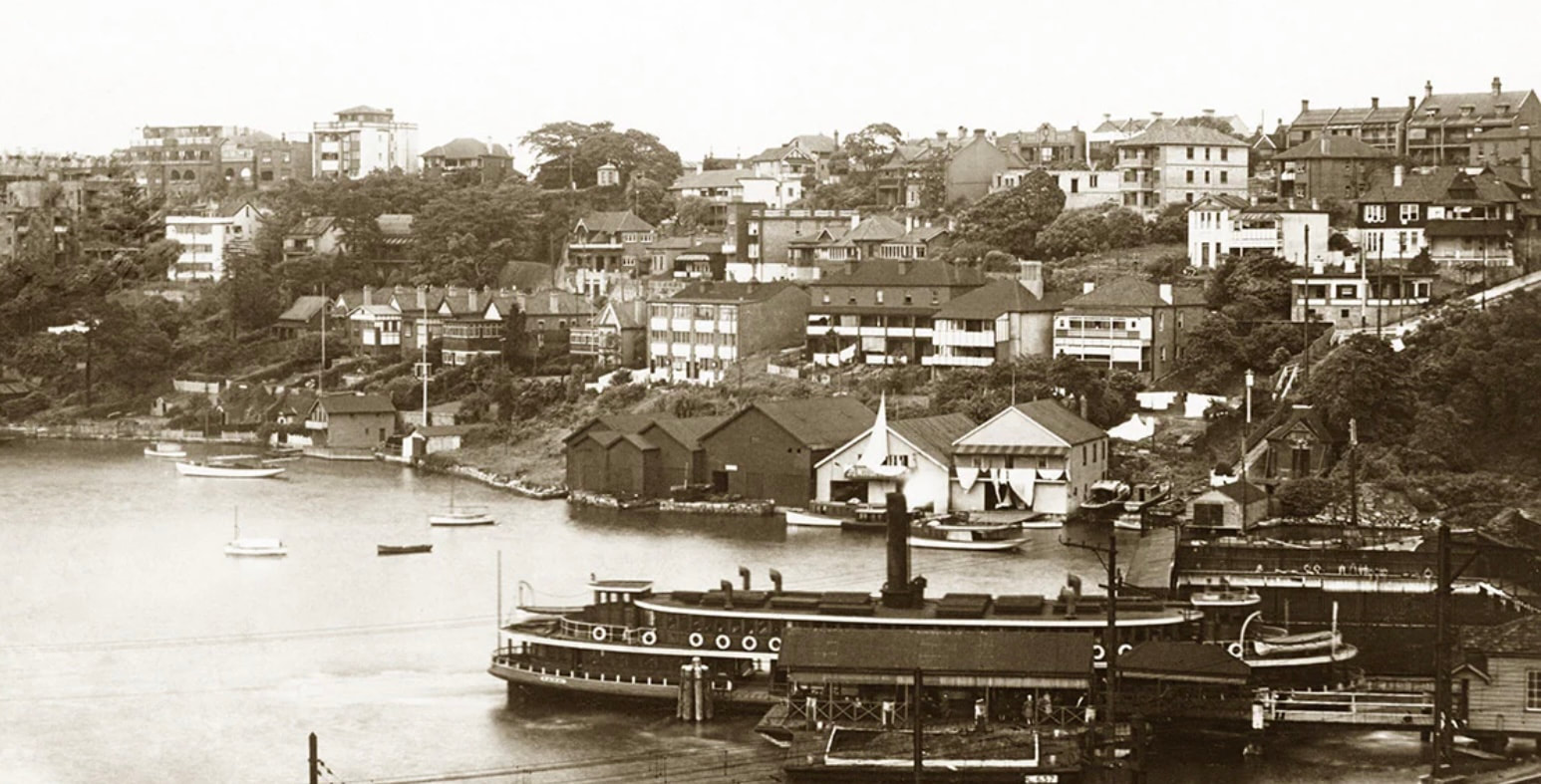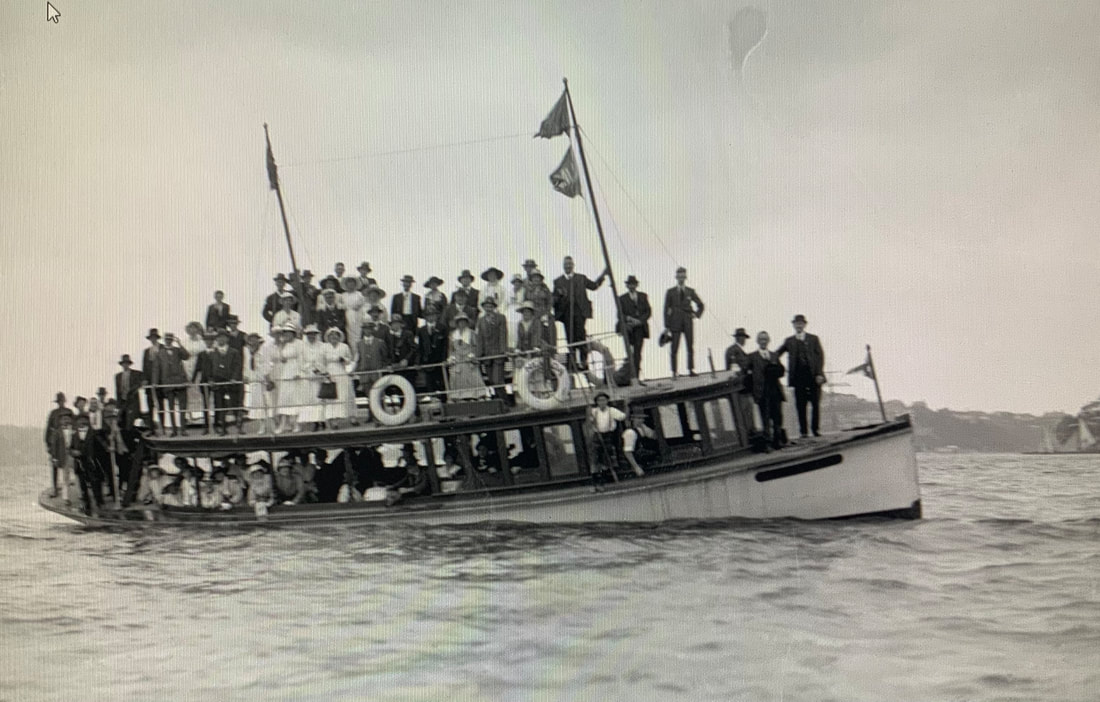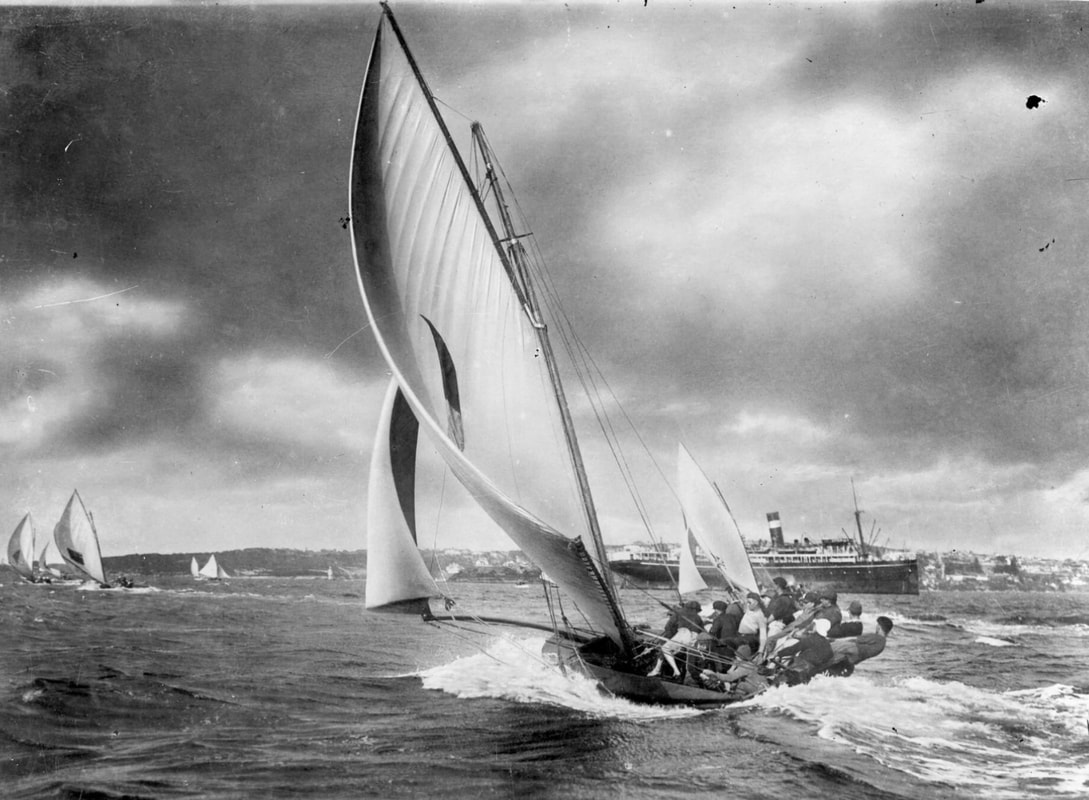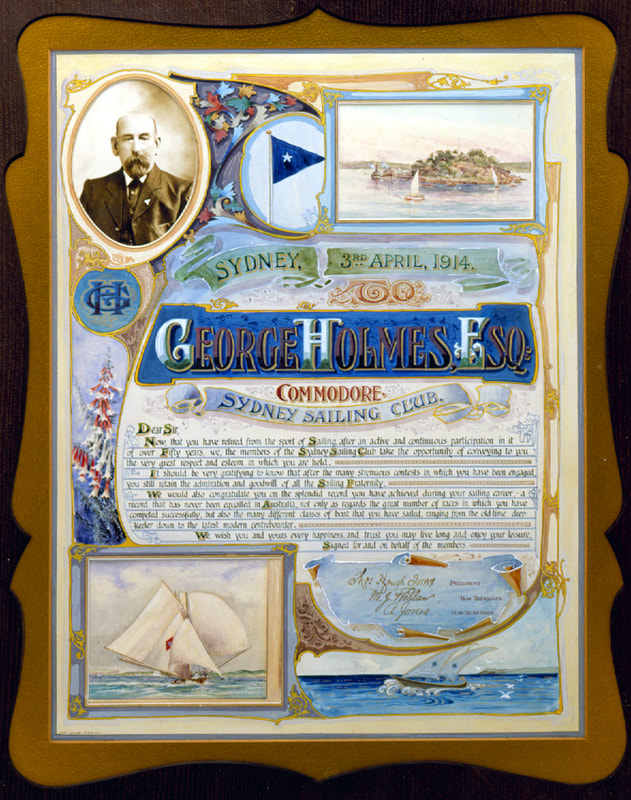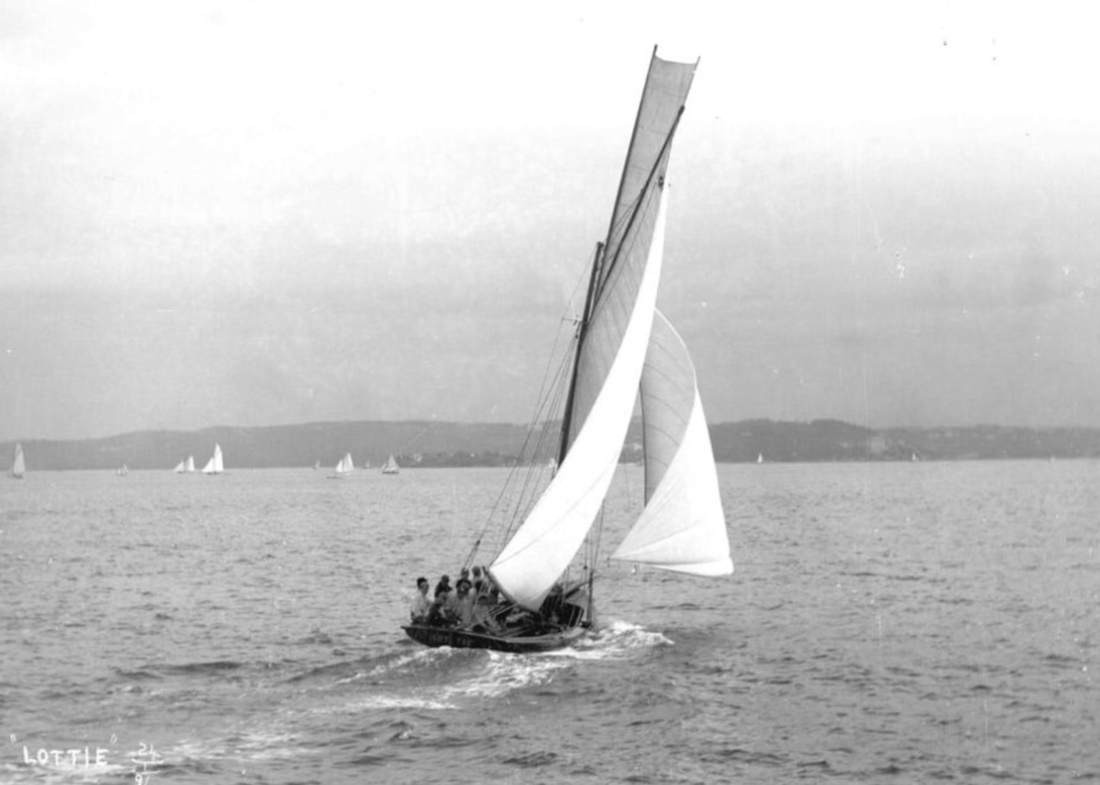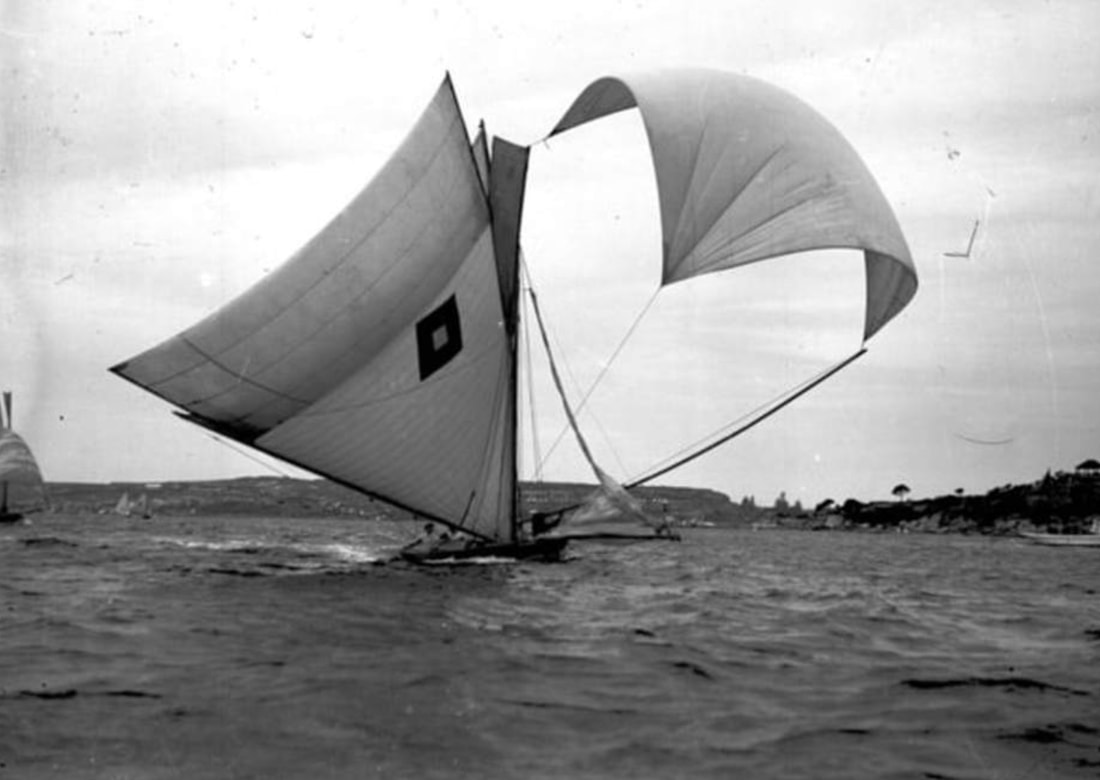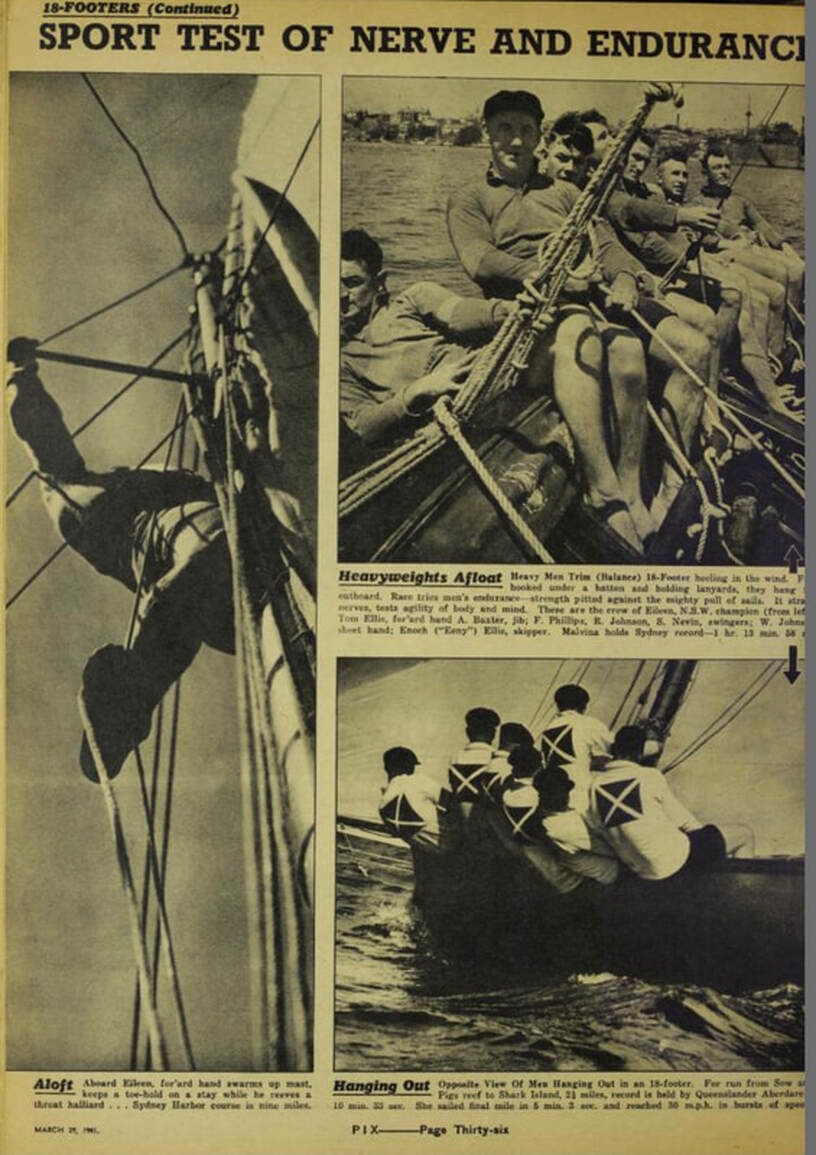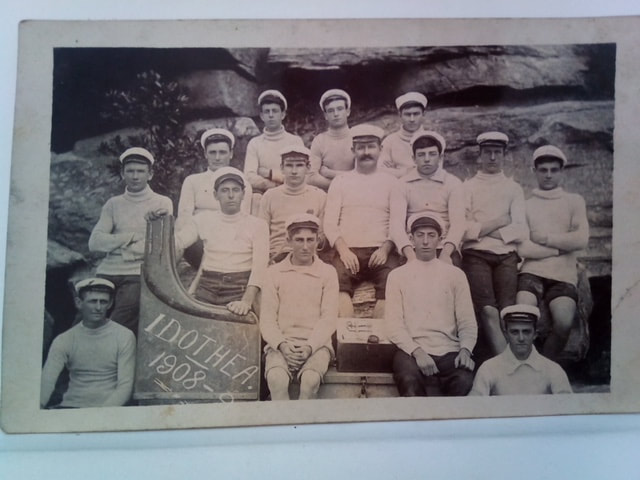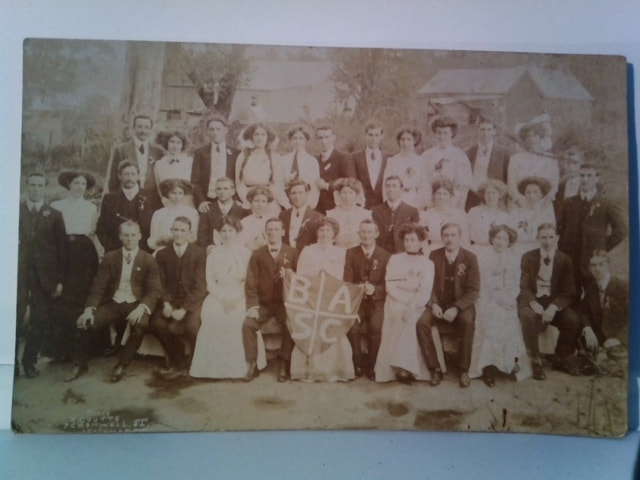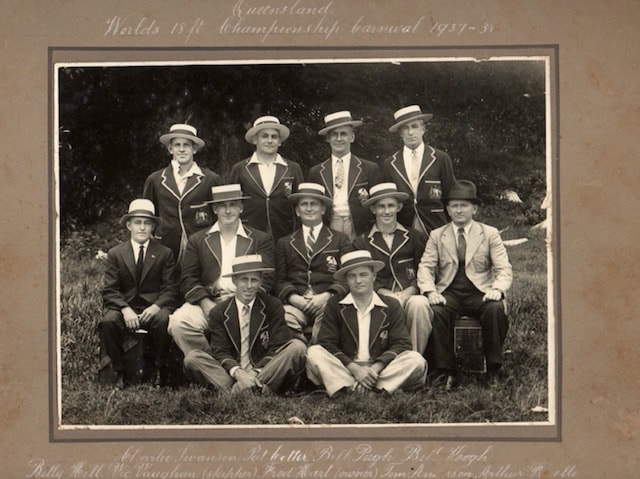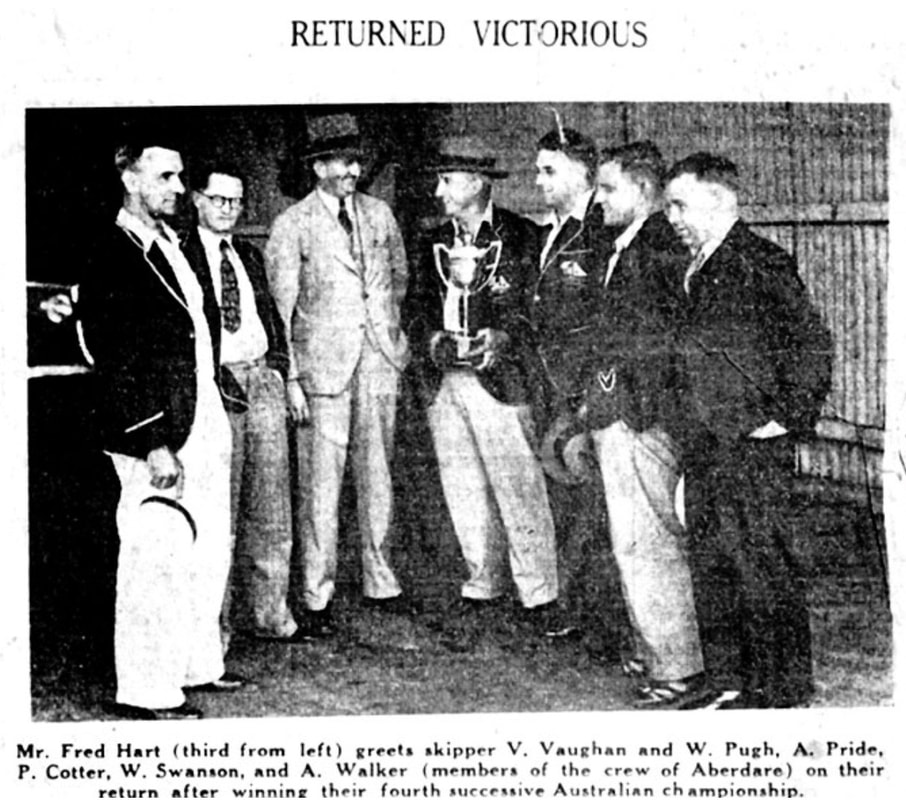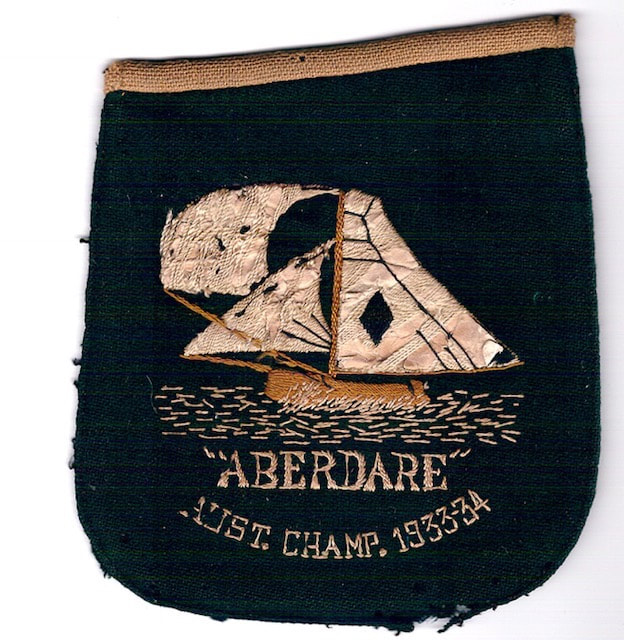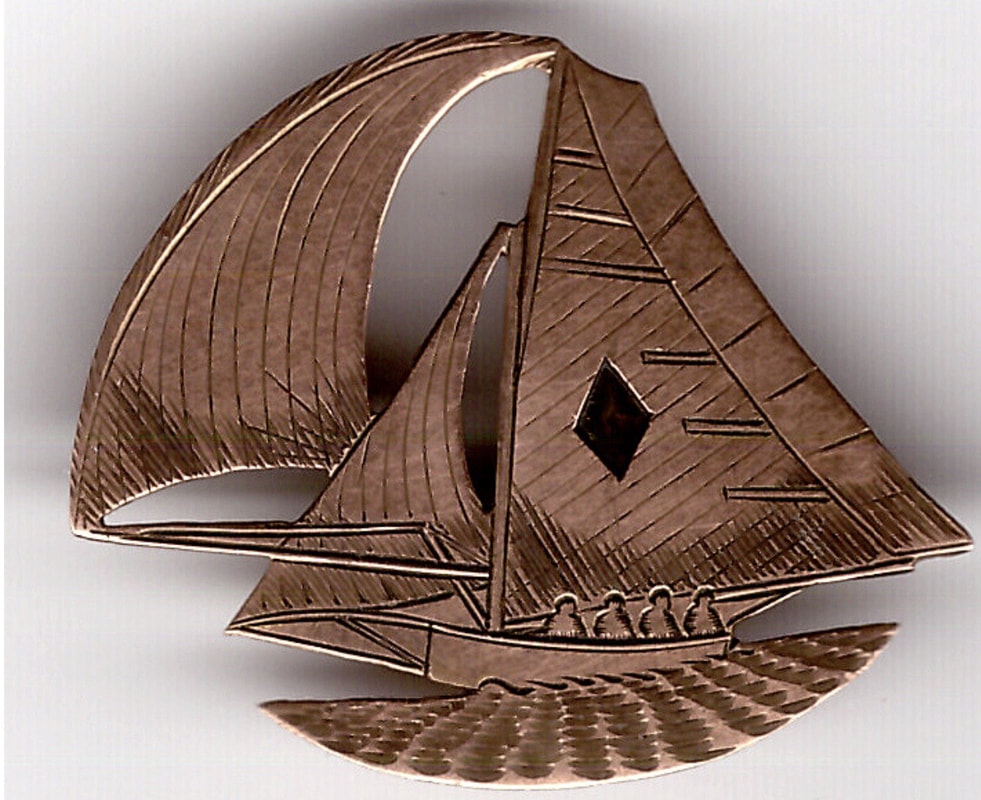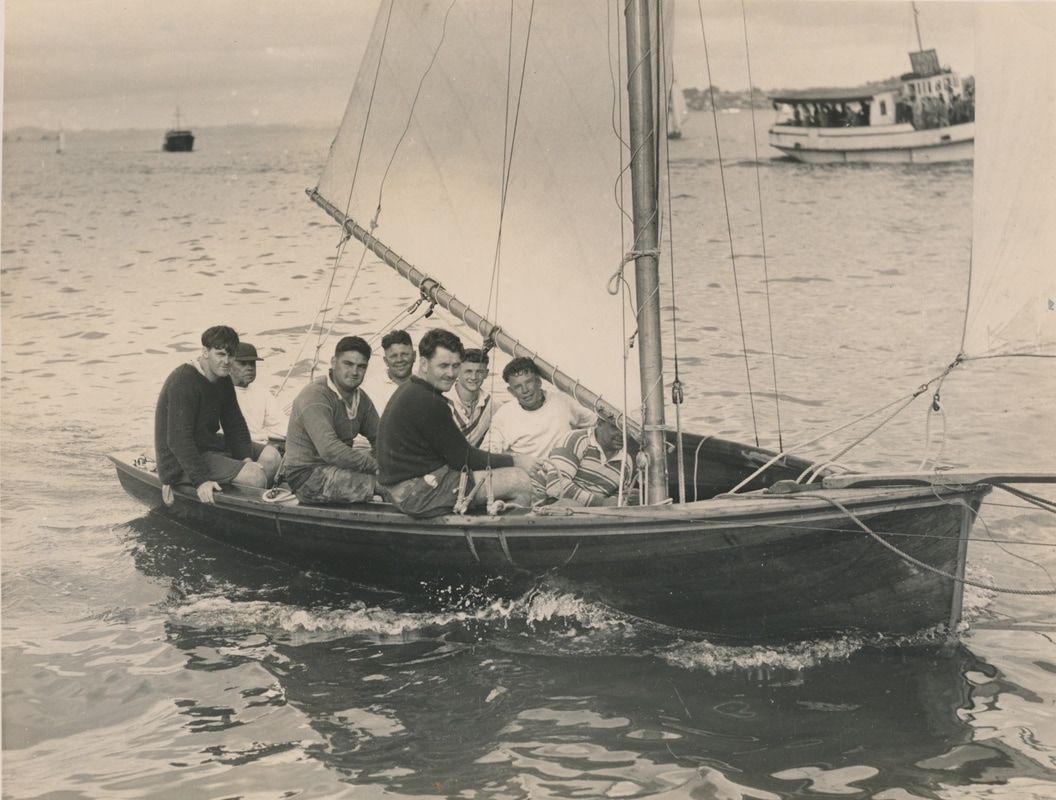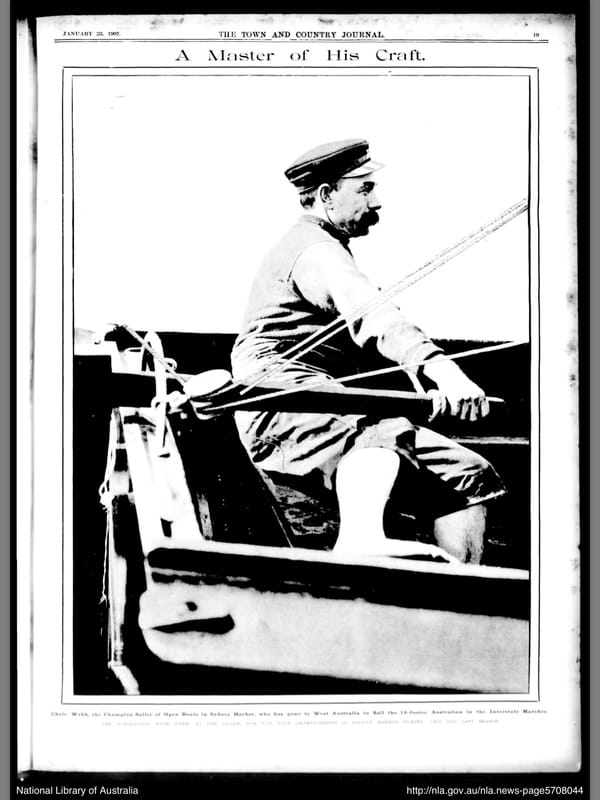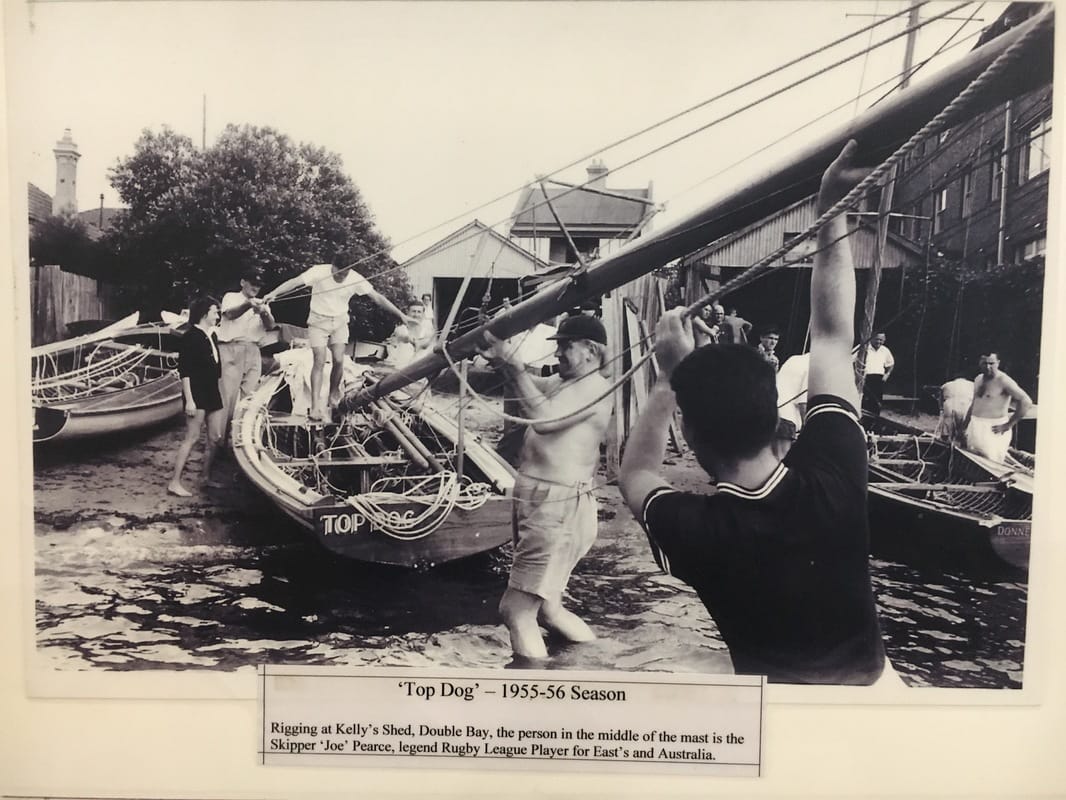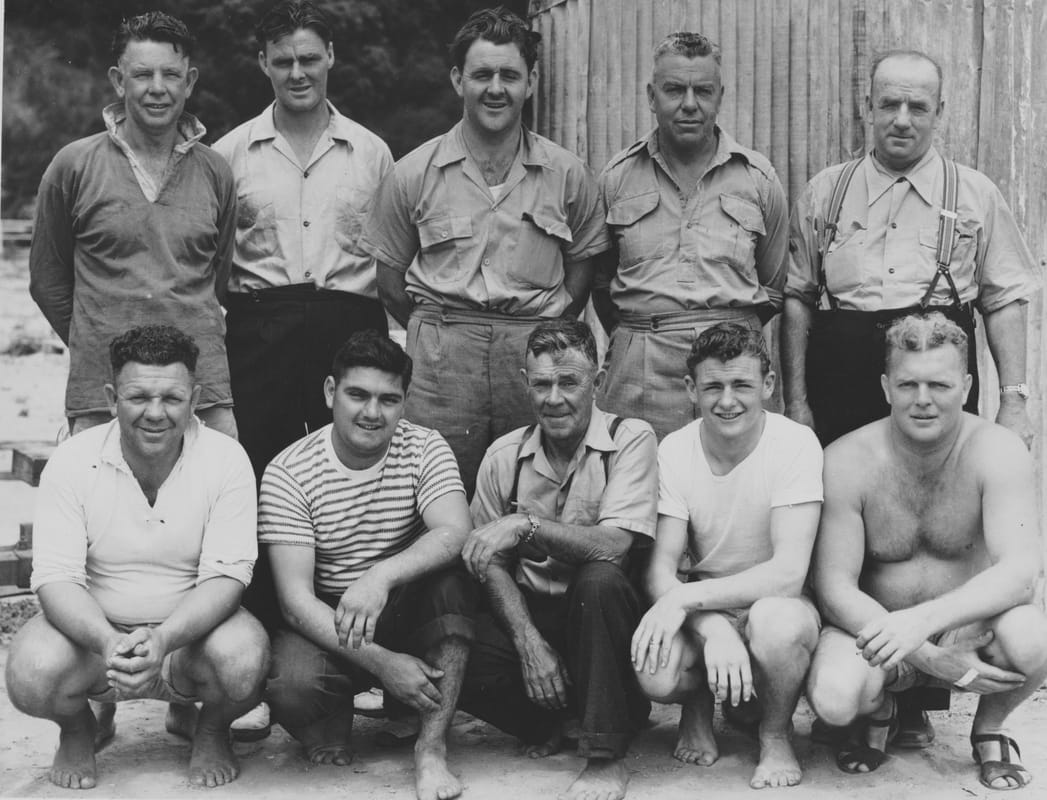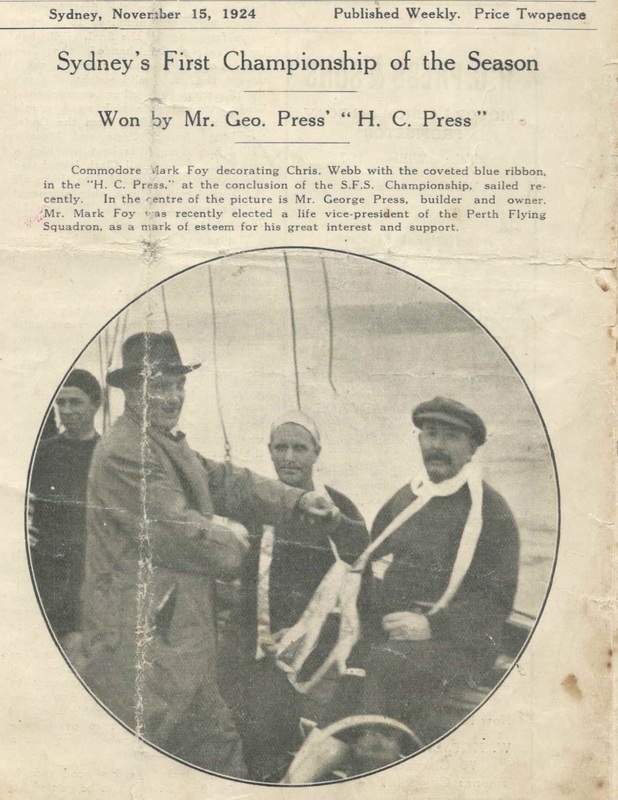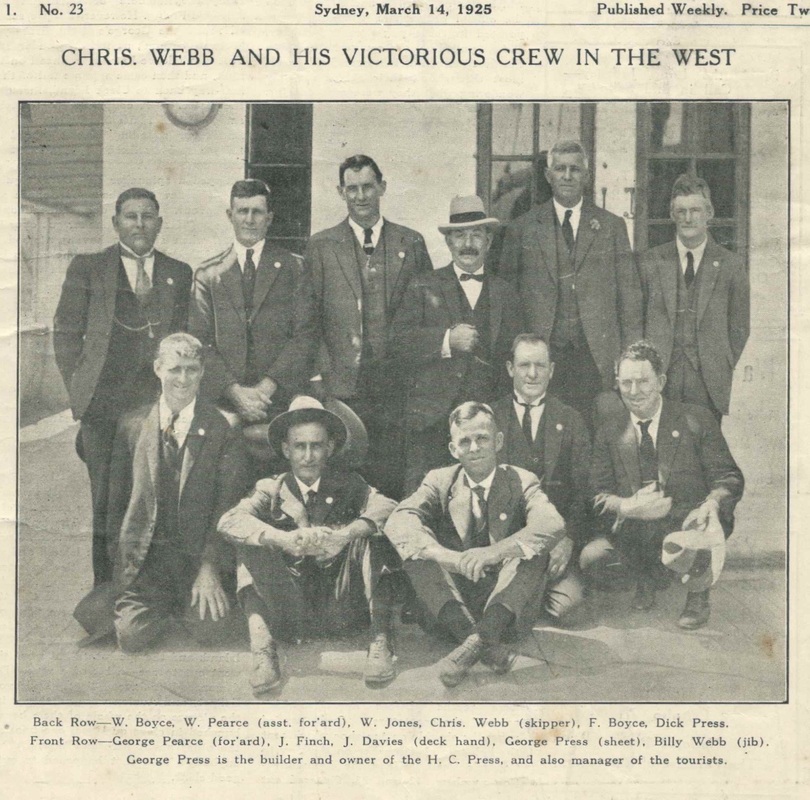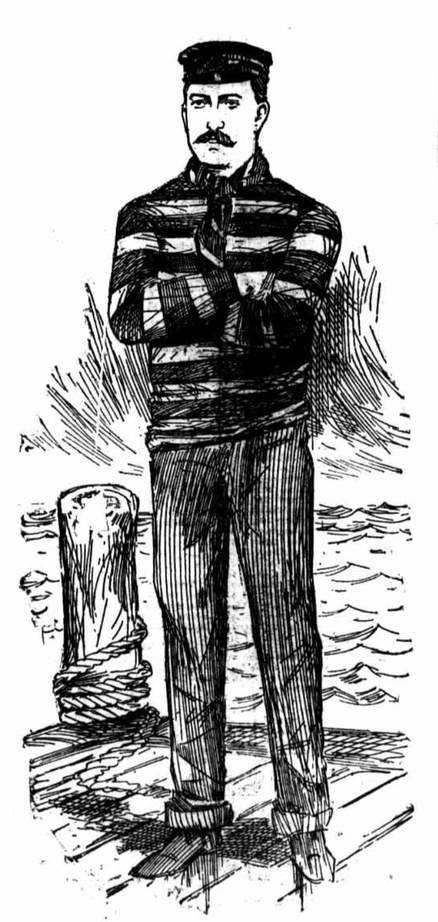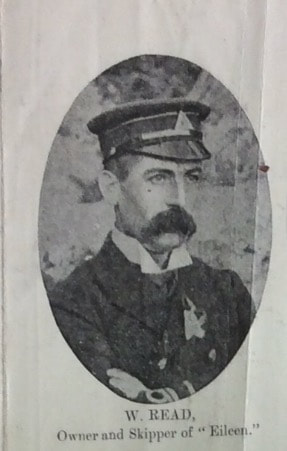This page has pictures and info on the personalities in Open Boat sailing during the 19th and early 20th Centuries. More pictures and info will be regularly uploaded. If you have pictures or info you think are relevant to the site, including info on family and descendants, get in touch through the Open Boat Facebook page or email info@sydneywoodenboatschool.com.au
Orlando "Lan" Taylor
Orlando “Lan” Taylor became known as the father of open boat sailing on Sydney Harbour in a long career of racing from the late 1870’s until 1939, as the owner of several legendary boats and through running his boatshed in Lavender Bay for many decades.

Born 29 December 1865 in Southern NSW where his father was a coach driver, Lan Taylor arrived in Sydney aged 10 with his family who settled in North Sydney. He bought his first sailing boat, a canvas dinghy named Raven aged 13. He began his working career at Sydney Ferries where he became an engineer and regular skipper. A report in 1946 claims he worked for Sydney Ferries for 33 years, and if this is correct his job would have overlapped his ownership of the boatsheds in Lavender Bay by more than a decade. More on this below. Lan married Violet Fanny Collins in 1893 and they remained together until her death in 1941. I can only find mention of one son, Artie who sailed with his father as frd hand in the late 1920’s.
Lan Taylor’s 22-footer Keriki sailing out of Lavender Bay for a race in 1905. This photo is on display in a frame at the Sydney Flying Squadron. The sheds are just out of sight at right.
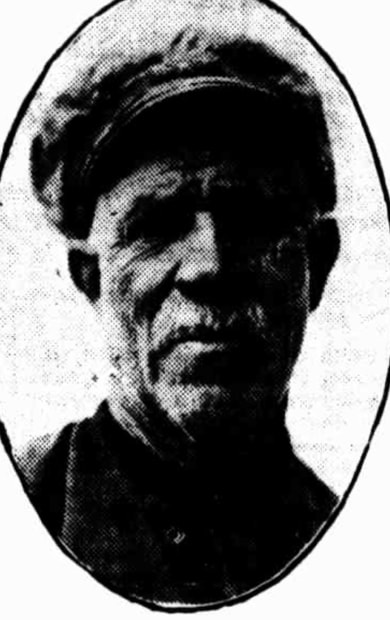
Lan got into the top levels of open boat sailing with the ownership of the 22-footer Latona from February 1892. Lan often steered the boat himself, but regularly engaged his childhood friend Chris Webb to steer, and the boat was successful under both of them. In early 1893 he started what became a bit of a habit for him when he challenged the 22-footer Secret to a private match, and won. He then challenged the 24-footer Mantura to a private match for stakes of £10 each and also won that. In both events Latona was steered by Chris Webb.
By the late 1890’s Latona was outclassed by newer 22-footers, so Lan commissioned Sam Williams the builder of the very successful 18-footer Australian (under Chris Webb) to build him a new 22-footer he named Keriki. The reason given by Lan for the name was that Sam Arnott had commissioned Joe Donnelly to build the 22-footer Plover and the “keriki is a New Zealand bird that bites the heads off plovers”. Plover had the upper hand at their first meeting, but thereafter Keriki was more often in front. Latona had carried Lan’s colours of a blue and red crescent as insignia, and he carried Latona’s sails and insignia over to Keriki. Lan raced Keriki with the 22-footer fleet and in general handicaps with the Sydney Flying Squadron and the Johnstones Bay Sailing Club, and then with its successor the Sydney Sailing Club up until 1913, long past the careers of most of the other 22-footers which went into decline in the early years of the 20th Century. Chris Webb was often found at the tiller in Championship events, whereas Lan steered in most of the handicap events.
Lan Taylor in the late 1920's
By the late 1890’s Latona was outclassed by newer 22-footers, so Lan commissioned Sam Williams the builder of the very successful 18-footer Australian (under Chris Webb) to build him a new 22-footer he named Keriki. The reason given by Lan for the name was that Sam Arnott had commissioned Joe Donnelly to build the 22-footer Plover and the “keriki is a New Zealand bird that bites the heads off plovers”. Plover had the upper hand at their first meeting, but thereafter Keriki was more often in front. Latona had carried Lan’s colours of a blue and red crescent as insignia, and he carried Latona’s sails and insignia over to Keriki. Lan raced Keriki with the 22-footer fleet and in general handicaps with the Sydney Flying Squadron and the Johnstones Bay Sailing Club, and then with its successor the Sydney Sailing Club up until 1913, long past the careers of most of the other 22-footers which went into decline in the early years of the 20th Century. Chris Webb was often found at the tiller in Championship events, whereas Lan steered in most of the handicap events.
Lan Taylor in the late 1920's
The Federal Boatsheds are the two light-coloured sheds just right of centre with sails hung out to dry. Several of his launches are moored out the front. For a time in the 1930’s Lan and Violet lived in the house above the sheds with a white chimney each side. The house still exists, the sheds have been extensively rebuilt. Sometime in the 1920’s.
In the 1905-06 season Lan bought the 18-footer Federal which had been built in 1898 by Billy Golding. It may have been about this time that he purchased the boatsheds in Lavender Bay, or changed their name, as the first mention I can find in a newspaper is that “Taylor’s Boatshed was quite demolished in a storm in March 1906 (Taylor was injured by flying debris). This suggests that he may have owned the sheds for some time already. The first mention I can find of the Federal Boatsheds in Lavender Bay is in an advert in September 1907. They are referred to as “Lan Taylor’s Federal Boatsheds" by at least May of 1909, advertising launches for hire to seat 12, 25 and 40 persons. Lan raced Federal quite a lot but was more often found at the tiller of Keriki. Both boats were also hired out around this time. Lan commissioned several large launches to be built for his fleet, including Nebraska (1911), Lavender, Nevada, and Newark. There were also boatsheds bearing the name Federal Boatsheds at Como on the George’s River, but I have not yet found any info that links them to Lan Taylor.
The launch Nevada with a crowd watching a race. In 1931 Taylor was charged with running a common gaming house as a group of men were discovered playing a game of two-up aboard. He was fined 10 pounds. Just as well the cops stayed away most Saturdays!
In 1912 Lan commissioned Sam Williams to build him a new 18-footer he named Quibree after a substantial house in Lavender Bay. The name derives from the indigenous name for the area. He carried over the red and blue crescent as insignia. Quibree was only moderately successful, and in 1920 Lan purchased the Norm Wright 18-footer Thelma III built in 1919 and renamed it Keriki. This boat sailed mostly mid-fleet for two decades, finishing up in 1939, by which time Lan was 74 years of age. In its career Keriki had 24 wins, 109 places and won £558 in prize money. His old friend Chris Webb often steered Keriki in the 1930’s after he left George Press’ stable. Lan regularly challenged other boats to individual matches but hardly anyone ever took him up on it.
Lan Taylor was always a popular figure with the other skippers and crews and with followers of the racing. Each of his boats was on the large size and carried big sails, and Lan was always expected to put on a good show. He also put an effort into training up young people in open boat sailing, his crew occasionally being referred to as “Taylor’s kindergarten”, although close-up photos of his crews show mostly men in their 30’s and 40’s. A strong swimmer, he was known to have saved 5 people from drowning in different incidents. He continued to run the Federal boatsheds after his retirement from sailing, and he died in June 1947 aged 81. The Federal boatsheds continued for a few more years before the name disappears from the records. The buildings still remain though substantially rebuilt, as the home of several marine businesses.
Lan Taylor was always a popular figure with the other skippers and crews and with followers of the racing. Each of his boats was on the large size and carried big sails, and Lan was always expected to put on a good show. He also put an effort into training up young people in open boat sailing, his crew occasionally being referred to as “Taylor’s kindergarten”, although close-up photos of his crews show mostly men in their 30’s and 40’s. A strong swimmer, he was known to have saved 5 people from drowning in different incidents. He continued to run the Federal boatsheds after his retirement from sailing, and he died in June 1947 aged 81. The Federal boatsheds continued for a few more years before the name disappears from the records. The buildings still remain though substantially rebuilt, as the home of several marine businesses.
Above: 18-footer Keriki in 1923 in a famous Hall image that was colourised for a Motor Boat and Yachting cover in 1924, and was enlarged into a huge mural at a trade exhibition in London also in 1924.
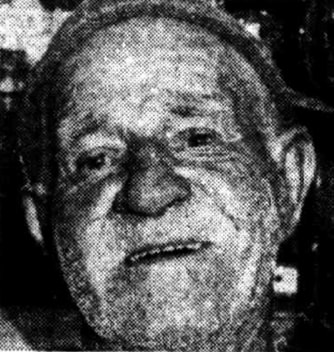
Right: Lan Taylor in 1946
**************************************************************************
George Holmes (Fletcher)
It’s about time we caught up with George Holmes one of the founders of our sport, who had a long association with the boatbuilder Joe Donnelly. Together they helped develop the 18-footer of the early 20th Century.
This illuminated address is on display at the Sydney Flying Squadron and was presented to George on his retirement from sailing by the board of the Sydney Sailing Club, which merged with the SFS a few years later.
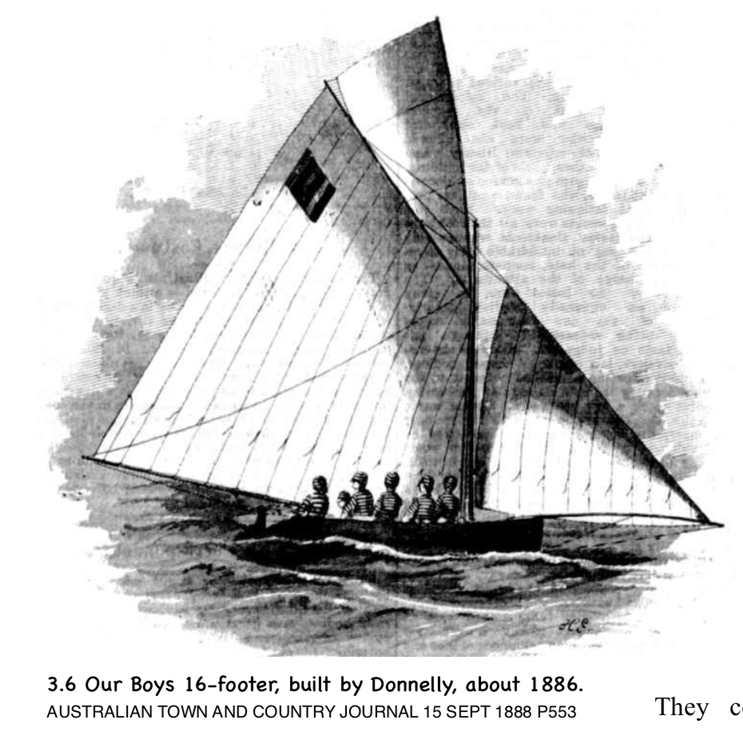
George Holmes was respected as one of the finest helmsmen of the late 19th and early 20th Centuries. Born in San Francisco USA between 1842 and 1845, he moved with his family to Sydney in 1855. His father died in the late 1850’s and his mother remarried William Fletcher, so for the rest of his life he was often referred to as George Fletcher but it appears that he preferred to be known as Holmes.
He started his sailing career within a few weeks of arriving as bailer boy for leading skipper George Montgomery and T and W Langford, sailors as well as leading boatbuilders at the time. In the 1860’s there was a class of 15-foot open boats prior to the arrival of centreboards, and as a young man George bought one of these named Eudora in 1863 and sailed it for 3 seasons winning several races including the North Shore Regatta. He then had another 15-footer named Tim Whiffler built for him and won 7 races in that.
By the mid-1870’s centreboards began to feature in the open boat fleet, and the 15-footers died out. One of the emerging classes was a class of 16’ skiffs, which were centreboard boats with unrestricted sail area and quite unlike the later 16-ft skiffs that developed in the early 20th Century. George was engaged to sail a 16-footer owned by Joe Monk named Alice and won 9 races in 11 starts. He then had a 16-footer named Our Boys built for him by Joe Donnelly with whom he developed a lifelong connection, and proceeded to win 15 races in 15 starts! Our Boys was referred to as the fastest 16-footer on Port Jackson, winning £250 prize money in the process. George raffled the boat after 5 seasons, and joined the stable of Sol Hyam who owned and campaigned open boats in several classes. The boats he sailed for Sol included the 19’ skiff Pandora and the 22’ skiff (unlike the later 22-footers which were not skiffs) Ettie, and the 24-footers Lottie and Carlotta, the latter three built by Donnelly. Pandora was built by Andrew Reynolds with whom Donnelly had apprenticed. George also sailed the 24-footer Victor (1879), owned by George Elliott and also built by Donnelly, including in a challenge with Carlotta steered by George Ellis. They raced twice around the Manly course for stakes of £100 to £80, a considerable sum of money in those days. Victor was beaten, it was said largely to bad crew work.
He started his sailing career within a few weeks of arriving as bailer boy for leading skipper George Montgomery and T and W Langford, sailors as well as leading boatbuilders at the time. In the 1860’s there was a class of 15-foot open boats prior to the arrival of centreboards, and as a young man George bought one of these named Eudora in 1863 and sailed it for 3 seasons winning several races including the North Shore Regatta. He then had another 15-footer named Tim Whiffler built for him and won 7 races in that.
By the mid-1870’s centreboards began to feature in the open boat fleet, and the 15-footers died out. One of the emerging classes was a class of 16’ skiffs, which were centreboard boats with unrestricted sail area and quite unlike the later 16-ft skiffs that developed in the early 20th Century. George was engaged to sail a 16-footer owned by Joe Monk named Alice and won 9 races in 11 starts. He then had a 16-footer named Our Boys built for him by Joe Donnelly with whom he developed a lifelong connection, and proceeded to win 15 races in 15 starts! Our Boys was referred to as the fastest 16-footer on Port Jackson, winning £250 prize money in the process. George raffled the boat after 5 seasons, and joined the stable of Sol Hyam who owned and campaigned open boats in several classes. The boats he sailed for Sol included the 19’ skiff Pandora and the 22’ skiff (unlike the later 22-footers which were not skiffs) Ettie, and the 24-footers Lottie and Carlotta, the latter three built by Donnelly. Pandora was built by Andrew Reynolds with whom Donnelly had apprenticed. George also sailed the 24-footer Victor (1879), owned by George Elliott and also built by Donnelly, including in a challenge with Carlotta steered by George Ellis. They raced twice around the Manly course for stakes of £100 to £80, a considerable sum of money in those days. Victor was beaten, it was said largely to bad crew work.
24-footer Lottie, one of Sol Hyam’s stable that George sometimes steered.
George often travelled to Newcastle, he is recorded as having sailed there many times in both McMurtrie’s 22-footer St Crispin (also built by Donnelly, in 1881) in which he won 7 out of 10 starts, and also steered a local boat owned by Clarence Hannell. He also sailed St Crispin in Sydney, as well as the 22-footer Irex, and won two 18-footer Championships in Ariel, both Donnelly-built. Up to the end of 1884, newspapers reported that George had entered 76 races out of which he won 41, was second in 22, third twice, and capsized 6 times.
In the early 1890’s there was a short-lived class of 20-footers, and George dominated this class with another Donnelly-built boat also named Victor, for owner Mr A Toogood. George is listed later as the owner of this boat, so he must have bought it off Toogod. He apparently dominated the class so much that he killed it, and the skippers and crews moved over to the 22-footers and the emerging 18-footers.
In 1896 George had William Clarke of Rozelle Bay build him an 18-footer to his own design he named Young George but the boat proved to be a disappointment and George spent more time sailing his 20’ Victor in SFS and Johnstones Bay Sailing Club races. He went back to Joe Donnelly in 1898 to build his next 18-footer which he named Donnelly as a tribute. He always claimed he had considerable input into the design of the boat as well and that his suggestions helped make it the phenomenal boat that it became.
George raced Donnelly all through the early period of development of the Australian 18-footer and by his very participation, being such a legend, helped make the 18’s the dominant class of open boat. George and Donnelly were always close to scratch and won many handicap races, and several Club Championships. George was always popular with the punters who knew he would always give his best, and he augmented his reputation for sportsmanship in 1903 in the Sydney Sailing Club Championship when Arawa and Australian collided. Australian capsized and Arawa was disqualified and Donnelly crossed the line for a win. But George handed back the Championship pennant and requested the race be run again. It was, later in the season, and Arawa won from Australian and Donnelly. George also had a reputation for handling the boat in hard weather, developed in numerous finishes in gales that flattened much of the fleet, including a race late in the 1912-13 season where Donnelly was the only boat to survive a SE gale.
In 1910 George had Joe Donnelly build him another 18, a narrower boat he named Donnelly II. Unfortunately they capsized in their first race. George persevered for a season and a half, but then went back to Donnelly (I) for the last few seasons of his career.
In the early 1890’s there was a short-lived class of 20-footers, and George dominated this class with another Donnelly-built boat also named Victor, for owner Mr A Toogood. George is listed later as the owner of this boat, so he must have bought it off Toogod. He apparently dominated the class so much that he killed it, and the skippers and crews moved over to the 22-footers and the emerging 18-footers.
In 1896 George had William Clarke of Rozelle Bay build him an 18-footer to his own design he named Young George but the boat proved to be a disappointment and George spent more time sailing his 20’ Victor in SFS and Johnstones Bay Sailing Club races. He went back to Joe Donnelly in 1898 to build his next 18-footer which he named Donnelly as a tribute. He always claimed he had considerable input into the design of the boat as well and that his suggestions helped make it the phenomenal boat that it became.
George raced Donnelly all through the early period of development of the Australian 18-footer and by his very participation, being such a legend, helped make the 18’s the dominant class of open boat. George and Donnelly were always close to scratch and won many handicap races, and several Club Championships. George was always popular with the punters who knew he would always give his best, and he augmented his reputation for sportsmanship in 1903 in the Sydney Sailing Club Championship when Arawa and Australian collided. Australian capsized and Arawa was disqualified and Donnelly crossed the line for a win. But George handed back the Championship pennant and requested the race be run again. It was, later in the season, and Arawa won from Australian and Donnelly. George also had a reputation for handling the boat in hard weather, developed in numerous finishes in gales that flattened much of the fleet, including a race late in the 1912-13 season where Donnelly was the only boat to survive a SE gale.
In 1910 George had Joe Donnelly build him another 18, a narrower boat he named Donnelly II. Unfortunately they capsized in their first race. George persevered for a season and a half, but then went back to Donnelly (I) for the last few seasons of his career.
George’s 18-footer Donnelly on a run. Hall Collection, ANMM.
Donnelly earned George £750 prize money over 15 years. In fact over his whole career George earned over £4,000 in prize money, which he claimed covered the costs of having boats built and all of their running costs. But George always considered himself an amateur, and held down a regular job all his life. He worked for decades on Cockatoo Island dockyard, becoming a Boilermaker foreman. He lived for the large part of his later life at 46 Louisa Rd Birchgrove, a waterfront property with a natural boatshed under an overhanging rock where Donnelly lived.
George Holmes announced his retirement from sailing mid-season in December 1913. He moved to a country property at Cudal west of Orange, around 200 miles inland. Two of his sons ( Percy and Sid Holmes) sailed Donnelly for a few more seasons, with George making occasional guest appearances at the tiller. George died on his country property “Donnellyville” in 1918.
George had six sons and at least one daughter. All the sons followed him into sailing, the eldest George Jnr (also known in the early days as George Fletcher Jnr) with the most success. Known as “Cubby”, George Jnr became almost as successful as his father, and may have surpassed him winning 85 races had George Jnr not died prematurely in 1899 from injuries he suffered at work on Cockatoo Island dockyard. George Snr’s grandson by his daughter was Bill Miller, a legend at the 18-footers League who was a long-serving Commodore of that Club and raced a series of 18-footers all 6 of which he named Donnelly, maintaining the family’s relationship with Joe Donnelly’s legacy.
George Holmes announced his retirement from sailing mid-season in December 1913. He moved to a country property at Cudal west of Orange, around 200 miles inland. Two of his sons ( Percy and Sid Holmes) sailed Donnelly for a few more seasons, with George making occasional guest appearances at the tiller. George died on his country property “Donnellyville” in 1918.
George had six sons and at least one daughter. All the sons followed him into sailing, the eldest George Jnr (also known in the early days as George Fletcher Jnr) with the most success. Known as “Cubby”, George Jnr became almost as successful as his father, and may have surpassed him winning 85 races had George Jnr not died prematurely in 1899 from injuries he suffered at work on Cockatoo Island dockyard. George Snr’s grandson by his daughter was Bill Miller, a legend at the 18-footers League who was a long-serving Commodore of that Club and raced a series of 18-footers all 6 of which he named Donnelly, maintaining the family’s relationship with Joe Donnelly’s legacy.
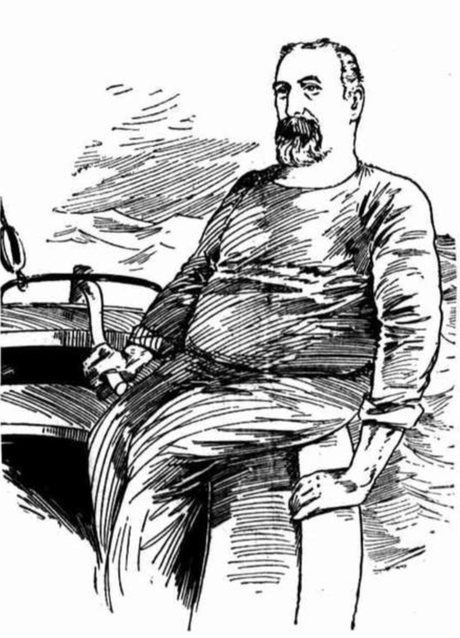
A contemporary newspaper drawing of George Holmes, 1890’s.
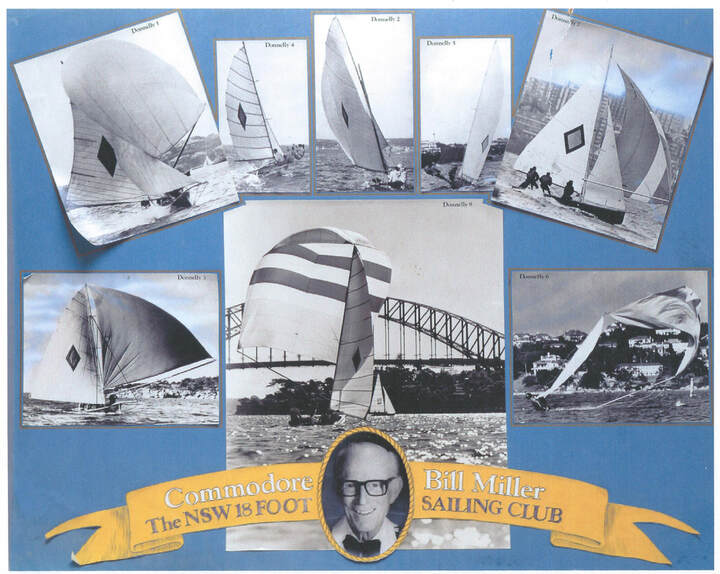
George Holmes’ grandson Bill Miller was sailor and Commodore at the League and named all 6 of his 18-footers Donnelly and carried his grandfather’s sail logo of blue diamond in a red diamond. He started out in 12-footers, which he also named Donnelly.
Group images first, alphabetical list of personalities below.
This group of photos and those below appeared in PIX magazine which was published weekly from 1938 to 1972. I only got to read it at the barbers. They stopped publishing it just a few years after i stopped getting my hair cut! The complete archive is online. They published these pages featuring Sydney's 18-footers in March 1941.
The crew of the Idothea*, a 24-footer built by Bob Stevens in 1888 and sailed in its later years at the Balmain Amateur Sailing Club. See entry for Idothea on the 24-FOOTERS Page. The BASC was a relatively short-lived club that originated around 1900 and disappeared with the War in 1914. They mainly sailed older boats no longer in the first-class fleets, with limited sails, and crews were restricted to amateurs (it was really a class thing to exclude manual workers). The picture below is of the social side of the Club about the same time. Both pictures were sent to the current Balmain Sailing Club by David Dunkerley whose Grandmother was associated with the Club and is probably in the photo.
This is a crew photo of the Brisbane 18-footer Aberdare* getting ready to defend their Australian title in Brisbane 1937-38. They had held the title for four years in a row before this from 1933-34 season. This time however they ended up 3rd to NSW's Billo Hayward in Malvina and fellow Queenslander Chick Ware in Betty II. But it was a great record in a legendary boat. For more details of the boat see Aberdare on the 18-Footers page on the menu.
Charlie Swanson, Pat Cotter, Bill Pugh, Bill Keogh
Billy Hill, Vic Vaughan (skipper), Fred Hart (owner), Tom Anderson, Arthur Frizelle
Roy Kingston, Bert Pride.
Charlie Swanson, Pat Cotter, Bill Pugh, Bill Keogh
Billy Hill, Vic Vaughan (skipper), Fred Hart (owner), Tom Anderson, Arthur Frizelle
Roy Kingston, Bert Pride.
A newspaper photo from the previous year sees some of the same men with their trophy. The photos were supplied by the descendants of Pat Cotter, shown in both photos. The family has also retained other memorabilia such as the blazer pocket and a badge shown below.
Queen of the Harbour Day in the 1930's. This photo comes from Christine George whose father Joe Wilkinson is the tallest head looking back. Joe was known to sail on Defiance in the 1930's and Dauntless in the 1940's, but this boat does not appear to be either of those. If it is Defiance, it must have been at a time when the name was not painted on the starboard side of the stern which is shown in other photos. Too many crew to be the later Dauntless. Photos of Defiance plus a brief history are now up on the 18-footers page on this site.
The World Champions in 1948 in Auckland, Billo Hayward and his crew in Crows Nest, built by Norman Wright Snr* as Iris in 1946. George Pearce (furthest left) was the regular skipper in Sydney, but suggested Billo as the skipper for Auckland because of his experience there in 1939. More on this event in Robin Elliott's Galloping Ghosts, available at Boat Books. This photo goes with the crew photo a few photos down this page.
Chris Webb, the Donald Bradman (cricketer...for Yanks think Babe Ruth in baseball) of Australian sailing pictured at the tiller of the 18-footer Australian* in 1907. This was the second Australian, built by Billy Golding and launched as Arline* in 1903. This might be a posed shot as no water is visible, nor is there any other crew who would usually be jammed up on the rail beyond Webb. Eventually full details of Webb's career will appear on this site on his own page such was his influence on the sport. From Australian Town and Country Journal 24 January 1907, found on www.trove.nla.gov.au
This shot in the collection of the Sydney Flying Squadron is at the tail end of the period we cover, but it's interesting in that it shows Top Dog (IV) built by Tom Fisher in 1949 and Donnelly III built by Bill Miller for himself in 1953, still both batten-seam carvel-planked though the new boats by then were being laminated. Both have Bermudan masts which had taken over by then. Eighteens being rigged onshore all around the Harbour was a common sight since the earliest days and only ended when road trailers came in (and waterfront real estate got too expensive for boatsheds!). Joe Pearce was the skipper of Top Dog and is also seen just a few years earlier in the photo below as part of Billo Hayward's crew.
Here's the gentle faces of the crew of Crows Nest, winner of the World 18-Footers Championship in 1948 in Auckland. Top left is the only one unidentified in this print in the AHSSA collection. Someone pointed out that he resembles the Haywards. Next is George "Raw Meat" Pearce, his brother Joe Pearce, Jack Hayward, Len Cantwell (owner of the boat). In front Tom Hayward, Skinny Boland, skipper Billo Hayward, Frank Shepherd and Harry "Thunder" Kerslake. Billo and his sons were Botany Bay oyster farmers. The story goes that Billo walked around the oyster farm barefoot and was told by boat owners to wear shoes on the boat so he didn't scratch the varnish!
Three of the legends of 18 footer sailing in one photo: Mark Foy was a wealthy businessman who started the Sydney Flying Squadron and largely subsided the development of Open Boat sailing. Chris Webb is the Donald Bradman of Australian sailing, the best skipper of all time. George Press was a boat owner and builder, was Webb's sheet hand for many years and later skippered his own boats, all named H.C.Press after his father.
Chris Webb won his eighth Australian Championship in Perth in 1925 in George Press' H.C.Press II with this crew of regulars. He won again in 1926 in Sydney in the same boat. He switched to Keriki for the 1929 and 1930 contests. George Press steered H.C.Press II into second place in the 1930 contest.
Alphabetical List of Personalities Follows: Owners, skippers and officials. Boatbuilders, whom I consider the most important have their own Page (see Menu).
Tom Colebrook
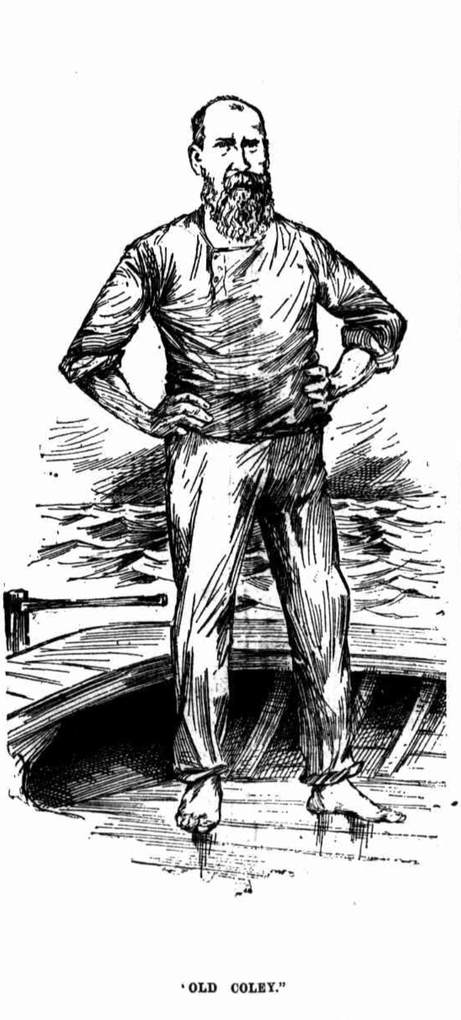
A leading skipper of the 19th Century. More to come.
W.J."Billy" Duncan
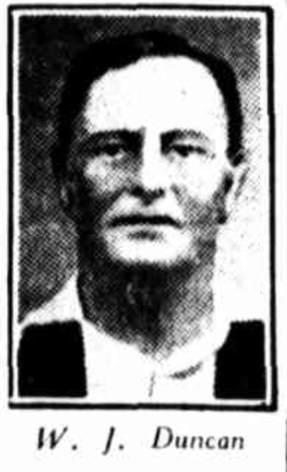
Billy Duncan and his cousin W.C."Trappy" Duncan were rival skippers in the 1920's and '30's. More info on both men will be posted eventually.
Jim Firth
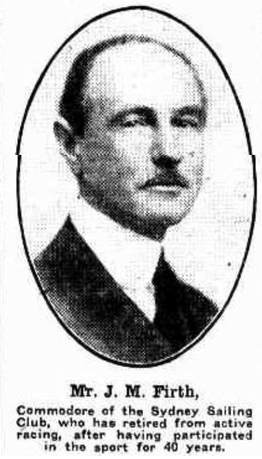
Jim Firth was a skipper, boat owner and club official during a long career from the 1880's to the 1920's. More details can be found under the entry for his 18-footer Onda on the 18-Footers Page.
Paddy Griffiths
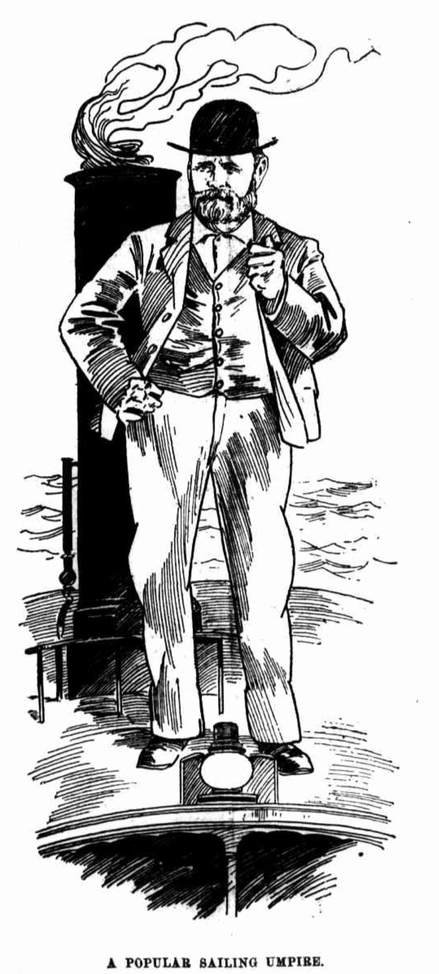
A well-respected club official and administrator. More to come.
Ossie Hahn

Oswald Hahn was an owner-skipper in the 1920's and '30's. More info to follow.
George Holmes (Fletcher)

George Holmes was a legendary skipper in the late 19th and early 20th centuries. George always maintained he was an amateur as he held down a regular job on Cockatoo Island Dockyard, though he won a lot of prize money. He retired (from work and sailing) in December 1913, moved to the country, and died in October 1918. George's story is now at the top of this Page.
Billy Read
Orlando (Lan) Taylor
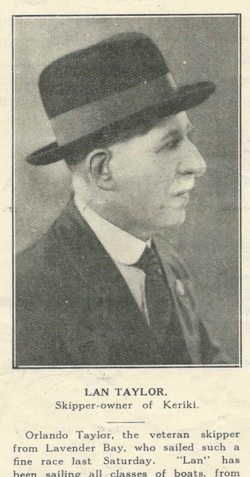
Lan Taylor ran the Federal Boatsheds in Lavender Bay for many years. He owned and often skippered his 22-footer Keriki built by Sam Williams in 1898 until 1913 by which time it was the last 22-footer regularly sailing. He had Sam Williams build him an 18-footer he named Quibree, and sailed it with middling success until 1919. He bought Norman Wright's 1919 eighteen footer Thelma III in 1920 and renamed her Keriki,and sailed her until the 1937-38 season.
Wesley West

Most well known for being the owner-skipper of the competitive Arline (II)* throughout the 1920's, West was a prominent Sydney jeweller with a shop in the Imperial Arcade in the City. He grew up in Balmain where as he said, every boy went sailing in the Summer, starting as bailer boy for his brother. He began to skipper his brother's 10-footer Valkyrie at the age of 14, with some success. He then built his own 10-footer Jessie and won many prizes including the Sydney Dingy Club Championship. As a young adult he dropped out of sailing to concentrate on business and became very successful. Ten years later he was persuaded out of retirement for just one race in 1921, and on the following Monday he started looking for a boat to own, and by the Saturday he had bought Arline II from Bill Fisher. He sailed her until 1930 with great success, including several Championships and was often off scratch in handicap events. He was a popular skipper with the punters and was a sponsor of the Sydney Flying Squadron, always advertising his business in the Club programme and often putting up prizes such as a wristwatch.
The Great Depression appears to have taken a toll on his business. In September 1933 he was charged with fraud for selling a ring that did not belong to him, and was sentenced to 9 months gaol. Arline was sold to his crew Bill Wark who shared the steering with Wes's brother Harry West (one of Sydney's leading sailmakers). I can't find any info on whether Wes ever sailed again, and he seems to have kept a very low profile after that. He was 46 years of age in 1933, so would have been born in 1887-88.
The Great Depression appears to have taken a toll on his business. In September 1933 he was charged with fraud for selling a ring that did not belong to him, and was sentenced to 9 months gaol. Arline was sold to his crew Bill Wark who shared the steering with Wes's brother Harry West (one of Sydney's leading sailmakers). I can't find any info on whether Wes ever sailed again, and he seems to have kept a very low profile after that. He was 46 years of age in 1933, so would have been born in 1887-88.
